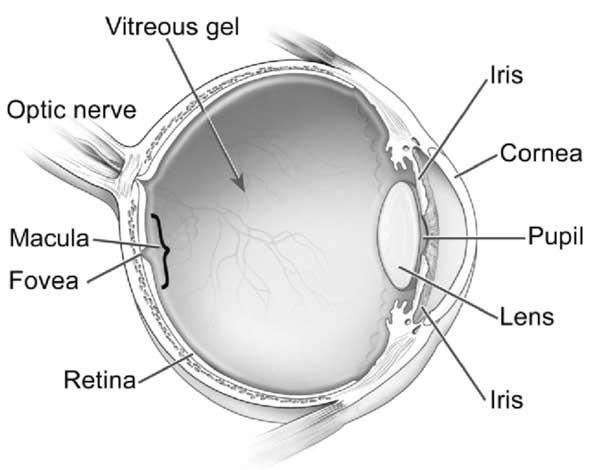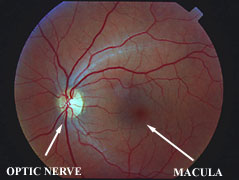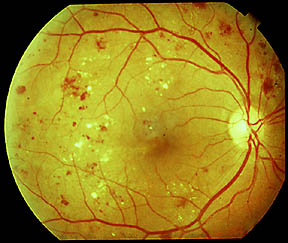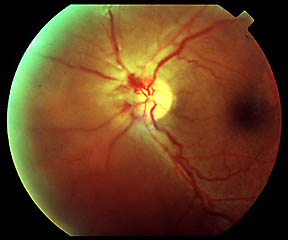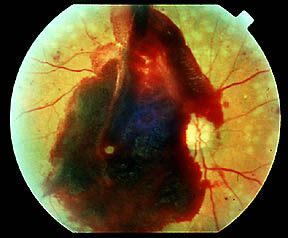Diabetes Mellitus and Your Vision
- Diabetes mellitus affects 14 million Americans.
- 25% of diabetics have some form of diabetic retinopathy.
- 20% of new cases of blindness between ages 45 and 74 are caused by Diabetic retinopathy.
- Blindness is 25 twenty-five times more common in diabetics than in non-diabetics.
However, proper management of diabetes and its complications for vision can reduce the risk of blindness by 90%. In the early stages, the patient may not have any symptoms, but still have a diabetic eye disease that can be easily seen in a thorough eye exam.
It is critical to get regular screening examinations to diagnose and treat the vision-threatening complications of diabetes.

The information below can help you understand more about diabetes and what you can do to prevent its complications.
Diabetes Mellitus: The Disease
There are two main types of diabetes:
Type I or insulin-dependent diabetes mellitus (also called juvenile diabetes)
Typically starts at a young age and requires insulin for treatment. Normally the pancreas produces a hormone called insulin, which moves glucose into the body’s cells to create fuel.
When the pancreas is not working properly, patients must take artificial insulin to keep their blood glucose at a safe level.
Type II or non-insulin-dependent diabetes mellitus
People with Type II diabetes are usually over the age of 40. The cause of diabetes mellitus is not completely known. Genetic, environmental, autoimmune, and infectious components may play a role in its development.
Type II is often controlled with diet and/or oral medications that lower the glucose level. High levels of glucose in the blood can damage many organ systems, including the eye.
Diabetic Eye Disease
Diabetes can affect vision in many ways.
High glucose levels can cause a temporary change in the shape of the lens, which impacts the focus of light on the retina. This can cause vision to fluctuate.
Cataract formation is another common cause of visual impairment in diabetic patients. Cataracts are opacities that develop in the normally clear lens.
Diabetic Retinopathy
Twenty percent of patients will develop diabetic retinopathy. The retina is a layer of cells in the back of the eye.
It functions like the film in a camera to capture what you are seeing so that it can be transmitted to the brain. There are two main types of diabetic retinopathy.
Background or nonproliferative diabetic retinopathy
In this type of diabetic retinopathy, the blood vessels in the retina leak and hemorrhage. If this affects the macular, the patient may notice a decrease in the central vision. Macular edema or swelling is the most common cause of visual loss in diabetic retinopathy.
Proliferative diabetic retinopathy
In this condition, new blood vessels grow in the eye. These new blood vessels tend to bleed and leak causing vision loss. They may also pull on the retina causing a retinal detachment.
Figure 1: Anatomy of eye
Figure 2: Fundus photo of normal macula
Figure 3: Hemorrhages in non-proliferative diabetic retinopathy
Figure 4: New blood vessel growth around optic nerve in proliferative diabetic retinopathy
Figure 5: Hemorrhage from new blood vessel growth in proliferative diabetic retinopathy
Prevention of Diabetic Eye Disease
The severity of diabetic eye disease is related to blood glucose levels. Research has shown that control of blood glucose reduces the risk, and delays the progression of diabetic retinopathy.
The most important thing for patients to do is to follow the treatment plan prescribed by their primary care physician. The right combination of medication, diet, and exercise will help control blood glucose levels.
Proper management of diabetes can help prevent the devastating complication of blindness.
Treatment of Diabetic Eye Disease
- Comprehensive Eye Examinations
- A patient under 30 years of age who is diagnosed with diabetes should be examined by an ophthalmologist within five years.
- Patients over the age of 30 who are diagnosed with diabetes should have an eye examination as soon as possible.
- Most patients should have a follow-up visit at least once a year. However, the ophthalmologist may want to evaluate more often depending on the severity of diabetic eye disease.
- It is important to have an eye examination at the start of a pregnancy and then at every three months, because pregnancy may worsen diabetic eye disease.
- Laser treatment of leaking blood vessels (focal laser) for macular edema reduces the risk of future vision loss by 50%. Laser treatment to the peripheral retina (pan-retinal photocoagulation) is used for proliferative diabetic retinopathy. It causes abnormal new blood vessels to stop growing and shrink. This type of laser treatment can reduce the risk of severe visual loss by 50%.
- Injections: Some patients may benefit from the injection of drugs into the vitreous cavity of the eye. This includes the use of anti-VEGF (vascular endothelial growth factor) agents, as well as corticosteroids. Research studies are being done to further assess how effective these treatments are when used specifically for macular edema associated with diabetic retinopathy.
- Vitrectomy is an operation to treat retinal detachment and hemorrhage (bleeding) caused by diabetes. The vitreous is a substance that helps give the eye its shape. A vitrectomy is performed by a retinal surgeon to remove the blood in the vitreous and also to reattach the retina.
- Cataract surgery is usually an extremely successful operation to remove the cloudy lens in the eye and implant a clear lens. Cataracts are a frequent cause of blurry vision, difficulty with night vision, and glare.

